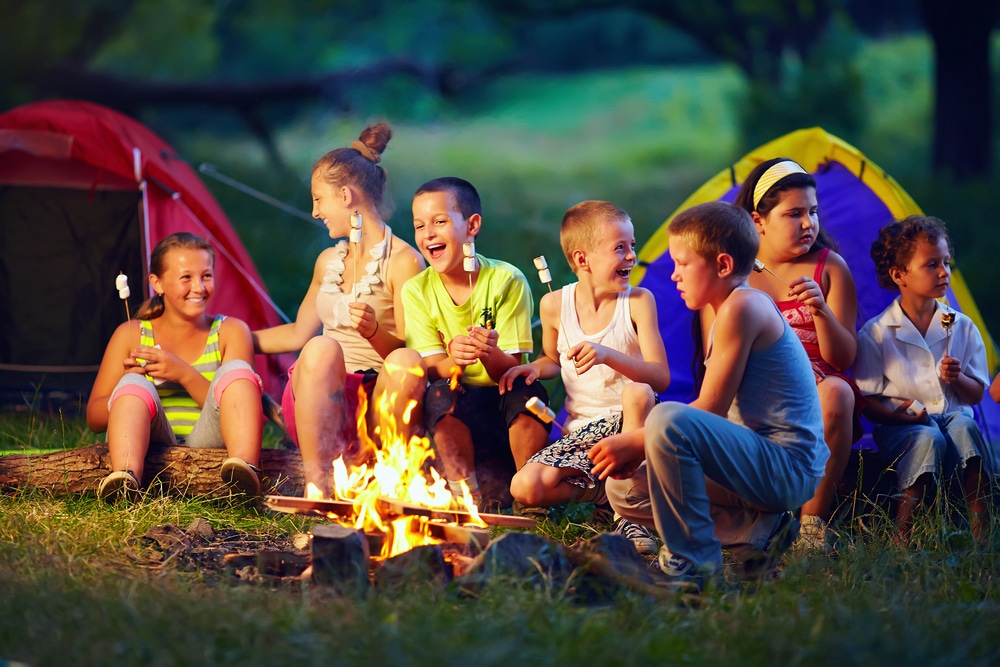9 English Camp Activities for ESL Students

If you (or your students) think you can’t have fun and learn English at the same time during summer camp, you’re wrong. You don’t have to sit at desks in front of a white board to be a successful language learner.
Here are nine excellent summer camp activities that you can use, with a little language twist, to make sure your campers are becoming stronger English speakers as well.
Contents
Download: This blog post is available as a convenient and portable PDF that you can take anywhere. Click here to get a copy. (Download)
1. Scavenger Hunts
What camper doesn’t love a good scavenger hunt? It’s part of the ritual of camp, and it’s simple to make sure your students are getting some language practice while searching. They probably won’t even realize they are learning when you try these fun versions of the typical list and seek.
- Description hunts: Rather than writing out a list of items for your students to find, try writing item descriptions instead. You can write simple descriptions (i.e. This piece of metal holds papers together. = paperclip), write your clues more in riddle form (i.e. Inside this box is gold for the taking, but there are no locks or keys to open it. = an egg) or do a combination. The point is that your students get some reading comprehension practice when they figure out what you are describing by your clue.
- Adjective hunts: If you want to focus on a certain part of speech, like the wonderful adjective, try giving your students a simple list of descriptive words rather than nouns to be found. They will then have to find something each adjective could be describing. If you do this version, be sure to include some adjectives your students might not already know to increase their vocabularies in the process. Try words such as “spherical,” “musty,” “submerged” or “rustic.”
- Vocabulary hunts: A language-twisted scavenger hunt doesn’t have to be complicated. On your list of items to find, simply include some words that are a part of your current vocabulary unit as reinforcement for your students.
No matter what type of scavenger hunt you do, consider making it a photo scavenger hunt, where students take pictures of the items they find rather than bringing back the items themselves.
2. Theme Tag
When I was a kid, I loved playing TV tag in gym class. The rules were very similar to traditional tag. One person was it, and that person ran around trying to tag someone else who would then become “it.”
In some versions of tag, players have a base that they can run to and be safe. In this version, you could be safe anywhere as long as you could name a television show.
Right before “it” tagged us, we would drop to one knee and call out a TV show. If you did this before “it” could tag you, you were safe. If “it” got to you before you called out your show, it was now your job to chase the other players.
We called the game “TV tag,” but you can use any theme at all: colors, animals, sports, etc.
The game gets played the same way; players must drop to one knee and call out an item in the chosen theme to be safe from “it.”
What makes this game great for ESL students is that you can choose any theme you want, and whatever it is, your students will learn new vocabulary words in that category. After they have played the game once, you can easily change up the theme for each game. Your students will have fun running around and not even realize they are hearing and learning new and unfamiliar words. (And they won’t need to carry a dictionary to do it.)
3. Backyard Scrabble
Have you seen the homemade versions of Scrabble that use your entire backyard as the playing board? They are so fun! Your students will think so, too, when they play this classic word game under the bright summer sky in your very own Backyard Scrabble game.
To make your game, first make your letter tiles out of cardboard or card stock, or print them out and laminate them. You will want your letters to have some sturdiness. Each letter should be about the size of a standard piece of printing paper.
Since the yard, field or open space is your “game board,” you’ll have to eyeball your rows and columns, keeping them as straight as you can. You won’t have lines on the ground to guide you where to put letters. Just do your best. It’s okay if things get a little (or a lot) crooked.
You also won’t have the double word and double letter spaces you’ll find on a traditional Scrabble board. So you’ll have to decide for yourself if you want to keep score. I think the fun is in playing rather than winning, so I often pass on keeping score when my ESL students play Scrabble—either inside or outside.
Other than that, you’ll play according to the traditional rules, swapping letters only at the expense of losing your turn and making sure each word played connects with another word already on the board.
Your students will learn new and unusual vocabulary (especially if you play, too), and I guarantee they’ll have a great time.
4. Go for a Hike
How well can your students follow directions? You’ll know if you send them on a hike with written directions.
If you are familiar with geocaching, you’ll have an idea how this hike will work. Hide a small prize for students to find. But instead of giving them latitude and longitude coordinates as you would with geocaching, give them a set of written directions to find the prize.
They will have fun searching, while getting some reading practice in the process.
5. Caption That
I don’t know about you, but I love to take fun pictures of my students. When you have kids at camp, you will have plenty of opportunities to take pictures of fun and interesting ESL activities.
When you do, print out your pictures and post them on a bulletin board. Then put some sticky notes nearby for your students to use when writing funny captions to go with each photo.
Students will love both writing their own captions and reading captions that their fellow campers have written. At the end of camp, compile your photos and captions into a photobook with your favorite desktop publishing program. Then make copies for each camper to take home to remember what a great time they had.
6. The Human Knot
This is a fun team building exercise where students must untangle themselves from, you guessed it, a human knot.
To set up, have everyone stand in a circle. Everyone puts their right hand into the circle and takes someone else’s hand—but not the hand of the person directly on their left or right. Then everyone puts their left hand into the middle and grasps another hand—but again, not the hand of the two people directly on their sides. (Here are clear video directions from the children’s show “Zoom.”)
Without letting go of any of the hands, students must untangle the knot of human limbs they have created. In the process they will have to talk to each other and strategize, and in so doing will get some great speaking practice.
When the knot is finally untangled, the students will be standing in a circle holding hands. (The perfect opportunity for you to snap a photo to caption later.)
7. Puppet Plays
If your students like arts and crafts, take some time one day to make puppets. You can use one of these ideas, the simple paper finger puppets here or one of your own.
After the puppets are complete, have groups of students come up with a puppet show for the other campers. You can have them write out the script or improvise. Either way, they will get in some language practice while entertaining their audience.
8. Nature Impressions
If your students like being in the great outdoors, try making impressions of items they find in salt dough or art clay.
Have students choose items such as branches, fern leaves, rocks, etc. and make impressions of them in a ball of dough. After the impressions have dried, see if everyone in the group can guess what their classmates used to make each of the impressions.
Heads up, this is a great time to use modal verbs or adverbs of frequency. (i.e. It could be a twig. It is most likely a pebble.)
9. Campfire Songs
What camp would be complete without a campfire and a guitar or two? You can use this time to get in some language practice too, by strategically choosing the songs you sing.
Try singing some grammar songs (such as those from “Schoolhouse Rock”) or songs that teach specific vocabulary. Take popular songs and rewrite the lyrics so they teach and/or review what you want your students to know.
Here’s a head’s up: If you are planning on singing around a fire in the dark, switch the print settings so you have white words on a black background. That way students will be able to hold them up to the fire and still see the words on the page.
English camp can be one of the most memorable experiences in a young person’s life. Make sure your camp makes the grade by merging summer fun with language development. Your students will be sure to count your camp as a best summer memory!
Download: This blog post is available as a convenient and portable PDF that you can take anywhere. Click here to get a copy. (Download)







